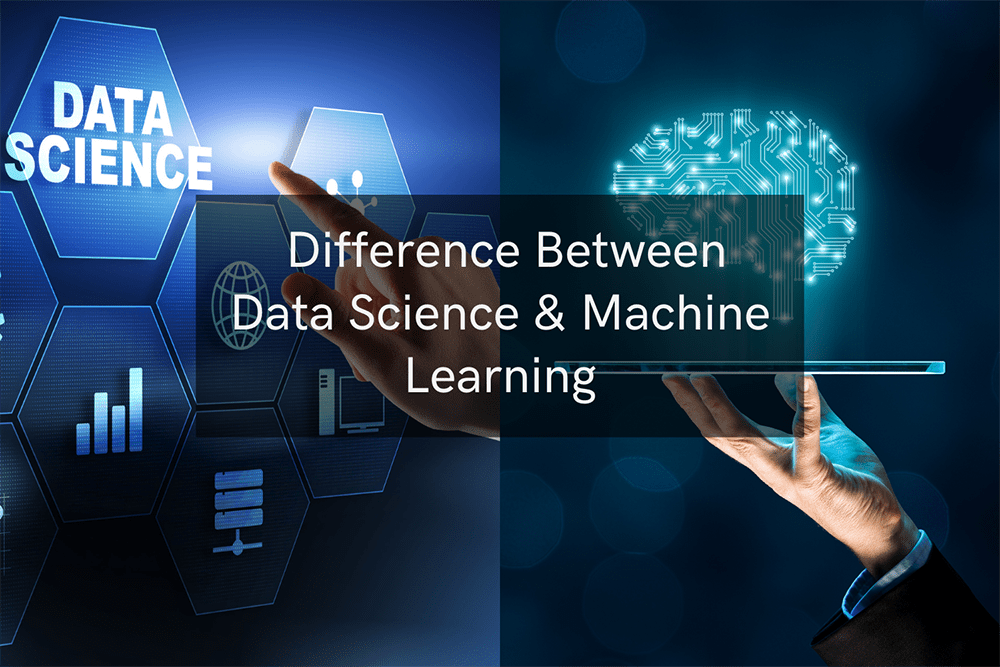Data Science is the study of data purification, preparation, and analysis, whereas machine learning is a branch of artificial intelligence and a subfield of data science. Data Science and Machine Learning are two popular current technologies that are expanding at an alarming rate. However, these two buzzwords, along with artificial intelligence and deep learning, are quite perplexing terms, so it is critical to understand how they vary.
In this post, we will simply look at the differences between Data Science and Machine Learning, as well as how they connect to one another.
Data Science and Machine Learning are closely connected yet have distinct functionality and objectives. At a glance, Data Science is a subject that studies methods for extracting insights from raw data. Machine Learning, on the other hand, is a technology employed by a group of data scientists to enable machines to learn automatically from prior data. To fully comprehend the distinction, let us first provide a quick overview of these two technologies.
What is Data Science?
Data science, as the name implies, is all about data. As a result, we may define it as “A area of deep data analysis that encompasses extracting relevant insights from data and processing that information using various tools, statistical models, and Machine learning algorithms.” It is a large data management concept that covers data cleansing, data preparation, data analysis, and data visualization.
A data scientist gathers raw data from multiple sources, prepares and pre-processes it, and then uses machine learning algorithms and predictive analysis to derive usable insights from the acquired data.
Netflix, for example, employs data science approaches to assess consumer interest by mining its users’ data and watching behaviors.
Skillset for a Data Scientist to have:
- Excellent programming skills in Python, R, SAS, or Scala.
- SQL database coding experience is required.
- Understanding of Machine Learning Algorithms
- Deep understanding of statistics topics.
- Data mining, cleansing, and visualization abilities are required.
- Knowledge of big data technologies such as Hadoop
What is Machine Learning?
Machine learning is a branch of Data Science and a subfield of artificial intelligence. It is a developing technology that allows machines to learn from previous data and complete a task automatically. It is defined as follows:
“Machine Learning allows computers to learn from prior experiences on their own, using statistical approaches to enhance performance and forecast output without being explicitly programmed.”
Popular ML applications include email spam filtering, product suggestions, online fraud detection, and so forth.
Machine Learning Engineer Requirements:
- Machine Learning Algorithms: Understanding and Implementation
- Natural Language Processing (NLP).
- Excellent programming skills in Python or R.
- Statistics and probability principles are required.
- Data modelling and data assessment expertise
Data Science Vs. Machine Learning:
| Data Science | Machine Learning |
| Data Science is concerned with comprehending and uncovering hidden patterns or helpful insights from data in order to make better business decisions. | ML is an area of data science that allows machines to autonomously learn from prior data and experiences. |
| It is used to get insights from data. | It is used to make predictions and categorize the outcome of fresh data points. |
| It is a wide phrase that encompasses the different processes involved in developing and deploying a model for a specific situation. | It is utilized as a full procedure in the data modelling stage of data science. |
| A data scientist must be able to handle big data technologies like Hadoop, Hive, and Pig, as well as statistics and programming in Python, R, or Scala. | Machine Learning Engineers must have computer science foundations, Python or R programming abilities, statistics and probability ideas, and so on. |
| It can operate with unstructured, organized, and raw data. | It usually works with structured data. |
| Data scientists spent a significant amount of time managing the data, cleaning it, and analysing its patterns. | ML engineers devote a significant amount of effort to handling the complications that arise during the implementation of algorithms and the mathematical principles that underpin them. |
Where is machine learning used in Data Science?
The application of machine learning in data science may be understood through the Data Science development process or life cycle.

Business Requirements: In this stage, we attempt to grasp the requirements for the business problem that we want to utilize it for. Assume we want to build a recommendation system with the goal of increasing sales.
Data Collection: In this stage, data is collected in order to address the specified problem. For the recommendation system, we may obtain the user’s ratings for various items, comments, purchase history, and so on.
Data Processing: In this stage, the raw data obtained in the previous step is processed into a suitable format for usage by the subsequent processes.
Data Exploration: This is the process in which we try to analyse the patterns in the data and extract relevant insights from it.
Data modelling: This is a process in which machine learning methods are applied. As a result, this stage encompasses the entire machine learning process. Importing data, cleaning data, developing a model, training the model, testing the model, and increasing the model’s efficiency are all part of the machine learning process.
Deployment and Optimization: This is the final phase in which the model is put on a real project and its performance is evaluated.


